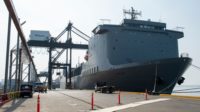Transportation
Bid Prices Put Nome, Alaska Arctic Port Project on Hold

The three-phase project to expand the Port of Nome would create the first Arctic deep-water port in the US.
Photo courtesy Port of Nome
The nation’s first Arctic deep-water port in Nome, Alaska, will have to wait, with the U.S. Army Corps of Engineers halting procurement of the $662-million project's first phase due to the pricing of bids received for the work.
Corps officials in its Alaska district cancelled the solicitation on Oct. 16, stating that bids received exceeded available project funding. The project was officially listed as “inactive” on Oct. 31, but that will change “as quickly as possible,” says the agency.
“We remain fully committed to awarding a construction contract for the Port of Nome Modification Project,” district officials said in a statement.
The number of bids and their amounts were not disclosed.
The Corps said the Procurement Integrity Act prohibits release of proposal information, including specific pricing details. The agency terms it “incorrect to say that the government estimate was unrealistically low,” stating that bids came in higher than expected.
About 90% of project funding is from the federal government with the remaining 10% from the city. Government procurement laws bar accepting contracts that are 25% over the cost estimate.
Sen. Lisa Murkowski (R-Alaska), who says she spoke with Corps leadership following the decision, insisted that officials "find a way to rectify these errors and present a timely path forward to get to construction."
She said she is "deeply frustrated by the Army Corps abrupt cancellation of the contract solicitation for the Port of Nome Phase 1 construction,” adding that the port expansion "is not just an Alaskan priority, [but is] imperative to our national security.”
Nome Mayor John Handeland said in a statement that the news “is a delay, not a cancellation.”
He called completion of the project vital to the city, region, state and nation. “It is disappointing that the ... project is experiencing another unexpected schedule interruption,” Handeland said, adding that the city was not given advance notice of the action because of strict federal procurement rules.
Nome officials plan to meet with the Corps to review a revised cost estimate to move forward within the available funding and have a revised solicitation by Jan. 15, he said.
The Corps said it will, along with the City of Nome, take the “information learned during the solicitation process” to assess the best way forward, and “continue to diligently work to bring this project to a successful contract award as quickly as possible.”
The Arctic Linchpin
The project will enable the port, also known as Nome Harbor, to handle more vessels at any given time and increase harbor depth from 22 ft to 40 ft, sufficient to adequately accommodate a range of vessels for trade, tourism and national security.
A project partnership between the federal and local government was signed in January 2024, with the original plan to award a contract in late summer 2024 and start construction in spring 2025. The pause puts those dates in question and the Corps said it is too early to discuss of any future decisions.
The main goal of the three-phase project is to enlarge the outer basin of Nome Harbor while creating a new deep-water basin. Dredging will deepen and maintain both the outer and deep-water basins and associated navigation channels. The first phase is expected to take three to four seasons, with full project completion originally anticipated in 2030.
Serving as a regional hub centrally located on Alaska's western coast, the Port of Nome was created in 1917 on the Seward Peninsula, adjacent to Norton Sound. It is located 545 miles northwest of Anchorage and has no access to major Alaska road systems. Government officials believe that Nome, with a population of 3,500, offers foundational importance to the viability of surrounding communities. The port also offers a launching point for vessels heading into Bering Strait shipping lanes.
Depending on the size of the ships in the port, the expansion will double or triple the number able to dock at one time. The 40-ft deep-water basin allows the port to accommodate large cruise ships, cargo vessels and every U.S. military ship smaller than an aircraft carrier.
Handeland previously said the U.S. has long needed a deep-water port to allow resupply and refueling services to the national security fleet operating in the Arctic.




